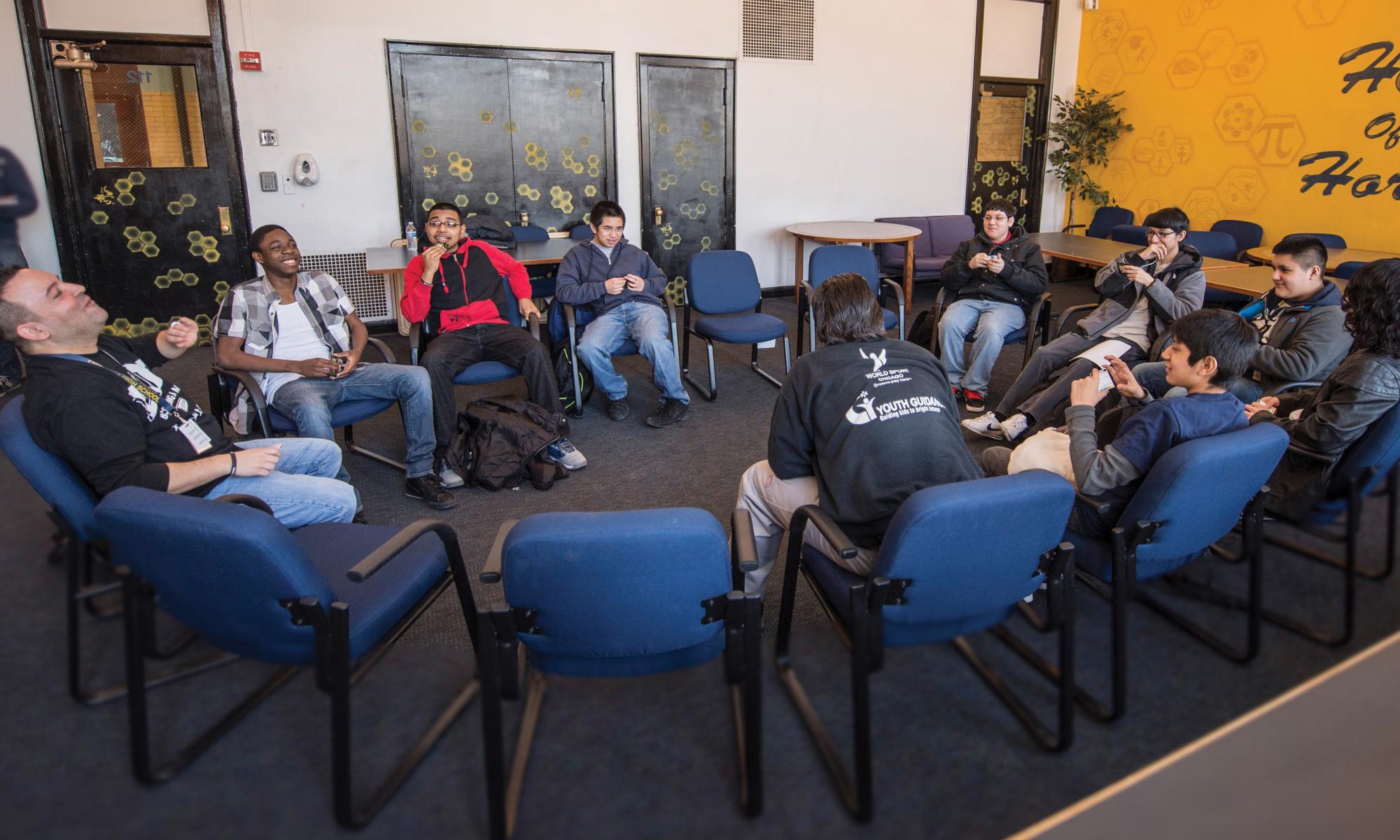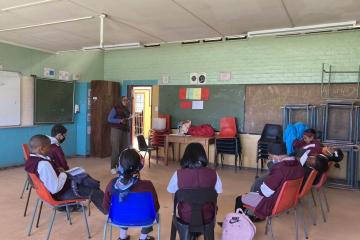
Training people to think differently in challenging situations can reduce violence and make communities safer.

To make communities safer, expand behavior change programs that train people to navigate high-stakes situations. These behavior change techniques are a replicable, scalable approach to reducing crime and violence.
Train non-specialist providers to maximize reach and impact. While mental health professionals are experts in delivering these programs, non-specialists can effectively deliver these programs and make them available to a wider range of people. However, organizations new to behavior change should get training from experts on how to implement evidence-informed models well.
Behavior change programs have potential to reach more people and improve public safety. Most evaluations looking at the impact of behavior change programs on crime have focused on young men or students, and this approach could be effective with other people who engage in violence or are tasked with maintaining public safety.
Crime and violence undermine safety, economic stability, and social cohesion. In both high- and low-income settings, poor violence prevention outcomes—like unnecessary arrests or excessive use of force—can also be socially costly and erode trust and safety. Policymakers are increasingly seeking violence prevention measures that better serve their communities.
Behavior change techniques like cognitive behavioral therapy (CBT) can help people slow down, think differently, and make safer choices. In tough situations, people often act on gut instinct. This leads people to make impulsive decisions based on biases that they may have otherwise avoided. Mental health professionals have long used CBT to address depression, anxiety, and PTSD. It has also been used to reduce recidivism. Now CBT-inspired programs and similar behavior change techniques are showing broader promise as an effective public safety tool for both civilians and law enforcement officers.
These techniques consistently reduce participants’ engagement in crime and violence across a wide range of settings. Eight studies showed positive results. For example, a program in the United States reduced students' arrests while also improving graduation rates. Behavior change techniques have also reduced recidivism and prison readmission in Canada and the US. Behavior change techniques have shown promise in low- and middle-income countries too. In Liberia, participants in a low-cost CBT program reduced their criminal and violent behavior up to ten years later. In El Salvador, students reduced violent behaviors and improved their academic performance.
Behavior change techniques can also improve law enforcement practices. Evidence from the Situational Decision-Making (Sit-D) program in the United States showed that training police officers to consider multiple interpretations of high-stakes situations reduced the use of force, arbitrary arrests, and officer injuries.

"Training people to overcome their automatic thinking fundamentally reshapes how they make decisions and reduces violence—whether applied to at-risk youth or police officers prone to excessive force."
—Oeindrila Dube and Chris Blattman, University of Chicago
Cost and design considerations
Behavior change programs offer good value-for-money given the substantial costs to society imposed by crime and violence. Researchers estimated that one program’s benefits were 3.5 to 18 times as large as its costs. The program reduced social harms through averted homicides and shootings, saving US$182,000 to US$916,000 per participant. (These estimates varied based on assumptions the researchers made, such as the social cost of different crimes or the likelihood of underreported crimes.) The Sit-D training program for police officers saved an estimated US$1,057 per officer over four months due to fewer injuries, offsetting program costs.
Effective programs often use simple curricula delivered by facilitators with similar backgrounds to participants. For example, in a program in the United States, facilitators often came from the same neighborhoods as participants and the program did not require them to have specialized training in psychology or social work. These approaches are easier to replicate at lower cost. Researchers estimate that the program’s societal benefits were 5 to 30 times greater than its costs (cost of US$1,850 per participant per year).
Programs should be targeted to people at the highest risk of engaging in crime and violence. These participants often changed their behavior the most, driving the largest impacts and cost-effectiveness. In the United States, when outreach workers referred men at the highest risk of gun violence to a group-based CBT and employment program, they observed fewer arrests and victimizations for shootings and homicides. By contrast, participants referred to the program through an algorithm did not see the same changes, possibly because outreach workers better identified individuals likely to engage with the program.
Encouraging results across income settings highlight the potential for cross-context learning to guide future program design and adaptation. For example, in South Africa, J-PAL and the Western Cape Government collaboratively designed and piloted a CBT-inspired program to address violence in schools, drawing on a previously evaluated program and adapting it to the South African context with local curriculum experts. Investing in strong learning partnerships can help with translating evidence to new contexts.
Expanding the reach of behavior change techniques is a promising direction for future research and programming. These approaches could be adapted to help a wider range of people navigate high-stress situations and avoid harmful decisions, including corrections and other security officers, people on probation, or people involved in organized crime. However, evidence on these groups is limited. New interventions should be carefully tested and adapted.
Programs should be targeted to people at the highest risk of engaging in crime and violence.
Implementing partners
Implementers bring deep local knowledge, technical expertise, and a commitment to evaluation and learning as they bring these programs to life. Partners include the following key collaborators (listed in alphabetical order); this list is not exhaustive.

The role of philanthropy
Strategic support from philanthropies, governments, and other actors can play a catalytic role in scaling up effective behavior change programs to improve community safety. Programs are drawing on the global evidence base to inform their work as they endeavour to increase the reach of behavior change techniques. In the United States, Ohio's Blue Ribbon Task Force recommended incorporating Sit-D into law enforcement training protocols statewide, receiving unanimous approval from the Ohio Peace Officer Training Commission. Further, the Office of the Independent Monitor for the city of Madison, WI, recommended Sit-D training for all officers in the Madison police department. Preliminary discussions are underway with three additional police departments that aim to do the training in 2026. In Colombia, Charity Entrepreneurship incubated ACTRA, a new CBT-inspired program to help young people avoid crime.
Many more evidence-based behavior change programs are actively scaling up their work. These efforts can benefit from critical investments to expand their reach and potential.
To generate more evidence to support this work, J-PAL North America's new Initiative for Effective U.S. Crime Policy will fund randomized evaluations on public safety, enforcement, and crime prevention policies that are both fair and effective, in partnership with Arnold Ventures.
Discover more from other sources
Scaling Promising Practices in Youth Mentoring
University of Chicago Crime Lab
Episode 88: Sara Heller & Max Kapustin on reducing gun violence
Probable Causation podcast
Episode 104: Oeindrila Dube on cognitive behavioral training for police
Probable Causation podcast
A new tactic for police reform: Using behavioral economics to curb unnecessary arrests
Becker Friedman Institute
Webinar | Shifting individual behaviors in high risk settings
Innovations for Poverty Action, J-PAL
Photos:
(1) Participants of the Becoming a Man program in Chicago speak with one another. Credit, Rob Kozloff, University of Chicago
(2) Participants of the Becoming a Man program in Chicago. Credit, Rob Kozloff, University of Chicago
(3) People walk through the streets of Monrovia, Liberia. Credit: Glenna Gordon, J-PAL/IPA


